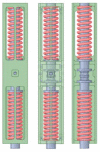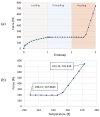Shape Memory Alloys Applied to Automotive Adaptive Aerodynamics
- PMID: 37445146
- PMCID: PMC10343273
- DOI: 10.3390/ma16134832
Shape Memory Alloys Applied to Automotive Adaptive Aerodynamics
Abstract
Shape memory alloys (SMAs) are gaining popularity in the fields of automotive and aerospace engineering due to their unique thermomechanical properties. This paper proposes a numerical implementation of a comprehensive constitutive model for simulating the thermomechanical behavior of shape memory alloys, with temperature and strain as control variables to adjust the shape memory effect and super elasticity effect of the material. By implementing this model as a user subroutine in the FE code Abaqus/Standard, it becomes possible to account for variations in material properties in complex components made of shape memory alloys. To demonstrate the potential of the proposed model, a skid plate system design is presented. The system uses bistable actuators with shape memory alloy springs to trigger plate movement. The kinematics and dynamics of the system are simulated, and effective loads are generated by the shape memory alloy state change due to the real temperature distribution in the material, which depends on the springs' geometrical parameters. Finally, the performance of the actuator in switching between different configurations and maintaining stability in a specific configuration is assessed. The study highlights the promising potential of shape memory alloys in engineering applications and demonstrates the ability to use them in complex systems with accurate simulations.
Keywords: FEM; actuators; adaptive aerodynamics; morphing; shape memory alloys.
Conflict of interest statement
The authors declare no conflict of interest.
Figures

























Similar articles
-
Special section on biomimetics of movement.Bioinspir Biomim. 2011 Dec;6(4):040201. doi: 10.1088/1748-3182/6/4/040201. Epub 2011 Nov 29. Bioinspir Biomim. 2011. PMID: 22128305
-
Shape Memory Alloy (SMA) Actuators: The Role of Material, Form, and Scaling Effects.Adv Mater. 2023 Aug;35(33):e2208517. doi: 10.1002/adma.202208517. Epub 2023 Jun 29. Adv Mater. 2023. PMID: 37074738 Review.
-
Review of Neural Network Modeling of Shape Memory Alloys.Sensors (Basel). 2022 Jul 27;22(15):5610. doi: 10.3390/s22155610. Sensors (Basel). 2022. PMID: 35957170 Free PMC article. Review.
-
Environment-Induced Degradation of Shape Memory Alloys: Role of Alloying and Nature of Environment.Materials (Basel). 2023 Aug 17;16(16):5660. doi: 10.3390/ma16165660. Materials (Basel). 2023. PMID: 37629951 Free PMC article. Review.
-
A 3-D constitutive model for pressure-dependent phase transformation of porous shape memory alloys.J Mech Behav Biomed Mater. 2015 Feb;42:292-310. doi: 10.1016/j.jmbbm.2014.11.023. Epub 2014 Nov 29. J Mech Behav Biomed Mater. 2015. PMID: 25528691
Cited by
-
Current Trends in Metallic Materials for Body Panels and Structural Members Used in the Automotive Industry.Materials (Basel). 2024 Jan 25;17(3):590. doi: 10.3390/ma17030590. Materials (Basel). 2024. PMID: 38591480 Free PMC article. Review.
References
-
- Gandhi M.V., Thompson B.S. Smart Materials and Structures. Chapman & Hall; New York, NY, USA: 1992.
-
- Huang W.M., Ding Z., Wang C.C., Wei J., Zhao Y., Purnawali H. Shape memory materials. Mater. Today. 2010;13:54–61. doi: 10.1016/S1369-7021(10)70128-0. - DOI
-
- Duerig T.W., Melton K.N., Stökel D., Wayman C.M., editors. Engineering Aspects of Shape Memory Alloys. Butterworth-Heinemann; London, UK: 1990.
-
- Pelton A.R., Hodgson D., Duerig T., editors. SMST-94. Proceedings of the First International Conference on Shape Memory and Superelastic Technologies, Asilomar, CA, USA, 7–10 March 1994. MIAS; Monterey, CA, USA: 1995.
-
- Pelton A.R., Hodgson D., Duerig T., editors. SMST-97. Proceedings of Second International Conference on Shape Memory and Superelastic Technologies, Asilomar, CA, USA, 2–6 March 1997. SMST; Santa Clara, CA, USA: 1997.
Grants and funding
LinkOut - more resources
Full Text Sources

